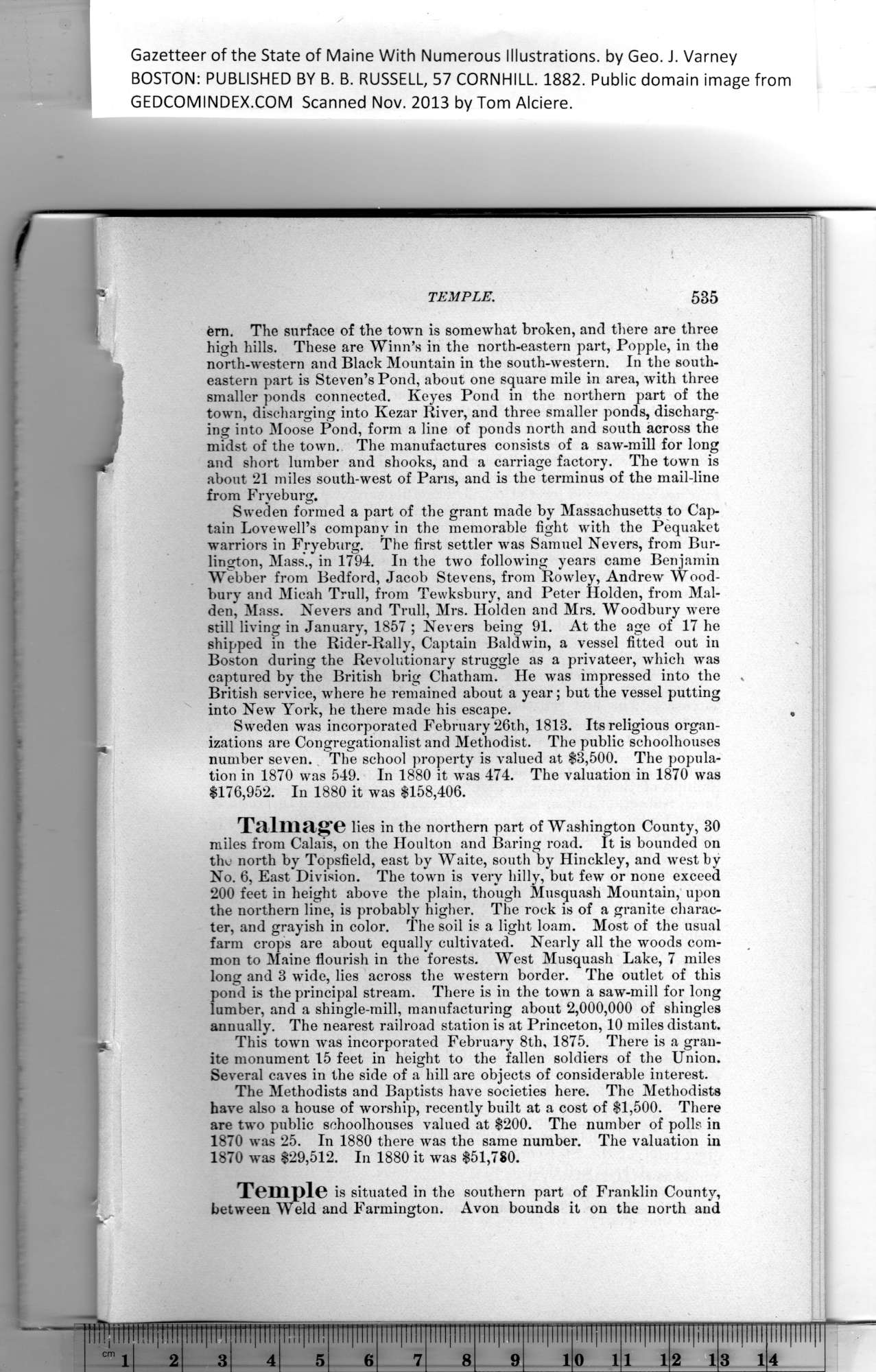|
Gazetteer of the State of Maine With Numerous Illustrations, by Geo. J. Varney
BOSTON: PUBLISHED BY B. B. RUSSELL, 57 CORNHILL. 1882. Public domain image from
TEMPLE. 535
em. The surface of the towrn is somewhat broken, and there are three
high hills. These are Winn’s in the north-eastern part, Popple, in the
north-western and Black Mountain in the south-western. In the south-
eastern part is Steven’s Pond, about one square mile in area, with three
smaller ponds connected. Keyes Pond in the northern part of the
town, discharging into Kezar River, and three smaller ponds, discharg-
ing into Moose Pond, form a line of ponds north and south across the
midst of the town. The manufactures consists of a saw-mill for long
and short lumber and shooks, and a carriage factory. The town is
about 21 miles south-west of Paris, and is the terminus of the mail-line
from Fryeburg.
Sweden formed a part of the grant made by Massachusetts to Cap-
tain Lovewell’s company in the memorable fight with the Pequaket
warriors in Fryeburg. The first settler was Samuel Nevers, from Bur-
lington, Mass., in 1794. In the two following years came Benjamin
Webber from Bedford, Jacob Stevens, from Rowley, Andrew Wood-
bury and Micah Trull, from Tewksbury, and Peter Holden, from Mal-
den, Mass. Nevers and Trull, Mrs. Holden and Mrs. Woodbury were
still living in January, 1857 ; Nevers being 91. At the age of 17 he
shipped in the Rider-Rally, Captain Baldwin, a vessel fitted out in
Boston during the Revolutionary struggle as a privateer, which was
captured by the British brig Chatham. He was impressed into the ,
British service, where he remained about a year; but the vessel putting
into New York, he there made his escape.
Sweden was incorporated February 26th, 1813. Its religious organ-
izations are Congregationalist and Methodist. The public schoolhouses
number seven. The school property is valued at $8,500. The popula-
tion in 1870 was 549. In 1880 it was 474. The valuation in 1870 was
$176,952. In 1880 it was $158,406.
Talmag,e lies in the northern part of Washington County, 30
miles from Calais, on the Houlton and Baring road. It is bounded on
the north by Topsfield, east by Waite, south by Hinckley, and west by
No. 6, East Division. The town is very billy, but few or none exceed
200 feet in height above the plain, though Musquash Mountain, upon
the northern line, is probably higher. The rock is of a granite charac-
ter, and grayish in color. The soil is a light loam. Most of the usual
farm crops are about equally cultivated. Nearly all the woods com-
mon to Maine flourish in the forests. West Musquash Lake, 7 miles
long and 3 wide, lies across tbe western border. The outlet of this
pond is the principal stream. There is in the town a saw-mill for long
lumber, and a shingle-mill, manufacturing about 2,000,000 of shingles
annually. The nearest railroad station is at Princeton, 10 miles distant.
This town tvas incorporated February 8th, 1875. There is a gran-
ite monument 15 feet in height to the fallen soldiers of the Union.
Several caves in the side of a hill are objects of considerable interest.
The Methodists and Baptists have societies here. The Methodists
have also a house of worship, recently built at a cost of $1,500. There
are two public schoolhouses valued at $200. The number of polls in
1870 was 25. In 1880 there was the same number. The valuation in
1870 was $29,512. In 1880 it was $51,780.
Temple is situated in the southern part of Franklin County,
between Weld and Farmington. Avon bounds it on the north and
PREVIOUS PAGE ... NEXT PAGE
This page was written in HTML using a program written in Python 3.2
|
